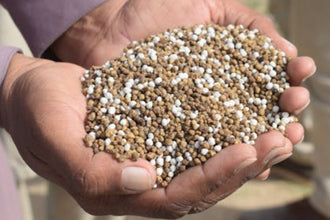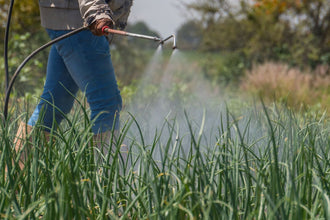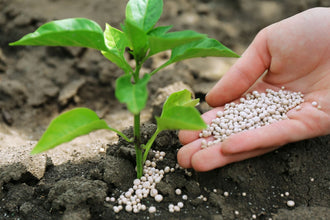
Fertilizer storage can make or break your gardening success. You might buy the best fertilizer money can buy, but if you store it wrong, you're basically throwing cash down the drain. Poor storage destroys the nutrients your plants desperately need.
Most gardeners don't realize how quickly fertilizer can go bad. Leave a bag in a damp garage for a few months, and you'll end up with a clumpy mess that won't spread properly. Store it where temperatures swing wildly, and the nutrients start breaking down before you even get a chance to use them.
Good fertilizer storage isn't rocket science, but it does require some planning. The money you save by protecting your fertilizer properly adds up fast. Plus, your plants get the full benefit of every nutrient you paid for.
Why Fertilizer Storage Actually Matters
You probably spend a good chunk of your gardening budget on fertilizer. Yet most people treat storage as an afterthought. They grab whatever space is available and hope for the best.
Bad storage ruins fertilizer in ways you might not expect. Moisture turns granules into concrete-hard chunks. Temperature swings break down the nitrogen compounds your plants need most. Even exposure to air can cause some fertilizers to lose their punch over time.
The worst part is that you often don't notice the damage until it's too late. Your fertilizer looks fine on the outside, but the nutrients inside have already started breaking down. You spread it on your garden expecting great results, but your plants don't respond the way they should.
What Happens When Storage Goes Wrong
Poor fertilizer storage creates a domino effect of problems. First, you waste the money you already spent on fertilizer that doesn't work anymore. Then you have to buy replacement fertilizer, which costs even more money.
Sometimes damaged fertilizer is actually worse than no fertilizer at all. Fertilizer that's gone bad can burn plant roots or throw off your soil's pH balance. You end up with sick plants instead of healthy ones.
Professional farmers track these losses because they add up to serious money. A single storage mistake can ruin thousands of dollars worth of fertilizer. Home gardeners face the same risks, just on a smaller scale.
The Science Behind Storage Problems
Fertilizer nutrients don't just sit there waiting to be used. They're constantly reacting with air, moisture, and temperature changes. These reactions can turn useful nutrients into compounds that plants can't absorb.
Nitrogen is the biggest troublemaker. It breaks down faster than other nutrients, especially when it gets hot or wet. Once nitrogen starts breaking down, there's no way to fix it. You're stuck with fertilizer that doesn't deliver the results you expect.
Organic fertilizers have their own set of problems. They contain living microbes that can die off if storage conditions aren't right. These beneficial bacteria and fungi are part of what makes organic fertilizer work so well. Lose them, and you lose a big part of what you paid for.
Different Types Need Different Care
Not all fertilizers store the same way. Synthetic granules hate moisture but can handle temperature changes better than you might think. Liquid fertilizers need protection from freezing but aren't as picky about humidity. Organic fertilizers want some airflow but still need protection from getting soaked.
The key is knowing what type of fertilizer storage challenges you're dealing with. Check the label on your fertilizer for basic storage info, but don't stop there. Real-world conditions often require extra precautions.
Synthetic Fertilizer Storage
Synthetic fertilizers dissolve in water really easily. That's great when you want to feed your plants, but terrible when moisture gets into your storage area. Even a little humidity can turn a whole bag of granules into one giant brick.
Here's what synthetic fertilizers need:
• Keep them bone dry at all times • Store in original sealed bags when possible • Use airtight containers if you need to transfer them • Avoid areas where humidity changes a lot • Don't worry too much about temperature unless it gets really extreme
Temperature isn't usually a big deal with synthetic fertilizers. They can handle being hot or cold without major problems. The exception is when extreme heat starts breaking down nitrogen compounds, but that takes pretty severe conditions.
Organic Fertilizer Storage Requirements
Organic fertilizers are trickier to store because they're alive. The beneficial microbes in organic fertilizer need some air to stay healthy, but too much moisture will kill them just as dead as synthetic fertilizer.
Organic fertilizers need this balance:
• Some airflow to keep microbes alive • Protection from getting wet • Steady temperatures when possible • No direct sunlight • Clean storage containers
The living microbes in organic fertilizer can actually help protect against some storage problems. They compete with harmful bacteria and mold that might try to move in. But once the good microbes die off, organic fertilizer can go bad really fast.

Setting Up Your Storage Space
The perfect fertilizer storage spot stays dry, keeps temperatures fairly steady, and has decent ventilation. Your basement might work great if it's not damp. A garage can work too, but watch out for big temperature swings.
You don't need anything fancy to store fertilizer properly. Focus on the basics first. Keep it dry, keep it sealed, and keep it away from extreme conditions.
Managing Temperature
Steady temperatures matter more than hitting a specific number. Fertilizer handles gradual temperature changes much better than rapid swings. A storage area that slowly warms up and cools down with the seasons won't cause major problems.
Indoor storage usually gives you the most stable temperatures. Even an unheated building often works better than outdoor storage because it protects against sudden weather changes. Avoid spots that get direct sunlight, since these areas heat up and cool down the most.
Controlling Moisture
Moisture control starts with picking a dry location. Don't store fertilizer anywhere that regularly gets humid or wet. Basements with water problems are out. So are sheds that leak when it rains.
You can help control moisture with these simple steps:
• Use moisture absorbing packets in storage containers • Keep fertilizer off concrete floors that might be damp • Check for leaks in your storage area regularly • Don't store fertilizer near water heaters or other moisture sources
The original fertilizer bag or container usually does a good job keeping moisture out. Don't transfer fertilizer to different containers unless you really need to. When you do transfer it, make sure the new container is completely dry first.
Choosing the Right Containers
The container you use for fertilizer storage can make a huge difference in how well your fertilizer holds up. The original packaging usually works best because it's designed specifically for that fertilizer. Manufacturers test their bags and containers to make sure they protect the product properly.
When you need different containers, pick ones that match your fertilizer type. Plastic works well for most fertilizers and won't rust like metal containers might. Make sure any plastic containers you use are food-grade quality to avoid chemical reactions.
Container Materials That Work
Different materials work better for different situations. Metal containers keep moisture out really well but can rust in humid conditions. Plastic containers are lighter and won't rust, but they need to be thick enough to keep moisture out.
Glass works great for small amounts of fertilizer but isn't practical for bigger quantities. It's heavy, breakable, and expensive. Most home gardeners find that good plastic containers give them the best combination of protection and convenience.
Proper Sealing and Labeling
A good seal is everything when it comes to fertilizer storage. Check your container seals regularly, especially after big temperature changes that can affect how well they close. Replace damaged seals right away to prevent moisture problems.
Label everything clearly to avoid dangerous mix-ups later. Include the fertilizer type, NPK numbers, when you bought it, and any special storage needs. This helps you use older fertilizer first and identify products that might be getting too old to use safely.
Common Storage Mistakes You Can Avoid
The biggest mistake people make is storing fertilizer in damp places without thinking about it. Garages, basements, and sheds often have moisture problems that slowly destroy fertilizer quality. Even small amounts of dampness cause big problems over time.
Another common problem is storing different fertilizers together without proper separation. Some fertilizer combinations can create dangerous reactions. Keep different types in separate containers and don't store them right next to each other.
Temperature Problems
Many storage areas go through daily temperature swings that gradually damage fertilizer nutrients. A garage that heats up during the day and cools down at night puts stress on stored fertilizer. This slow damage often goes unnoticed until fertilizer performance drops.
Choose storage locations that stay fairly steady temperature-wise. Insulated buildings protect fertilizer better than structures without insulation. Underground or partially underground storage areas usually have more stable temperatures.
Preventing Contamination
Contamination ruins fertilizer and can create safety problems. Store fertilizer away from pesticides, gasoline, and other chemicals that might leak or create fumes. Clean storage containers thoroughly before adding new fertilizer to prevent contamination from old products.
Watch out for pests too. Mice and rats can chew through fertilizer bags and contaminate your whole supply. Use containers that pests can't get into, and check your storage area regularly for signs of animal problems.
Seasonal Storage Adjustments
Your fertilizer storage needs change with the seasons as weather conditions shift around. Summer storage requires extra attention to heat and humidity control. Winter storage might need freeze protection for liquid fertilizers and measures to prevent condensation problems.
Spring and fall bring rapid weather changes that can stress your storage system. Check on stored fertilizer more often during these transition periods to catch problems before they get serious.
Different parts of the country have different storage challenges. Desert areas make heat control the main concern, while humid regions require aggressive moisture management. Cold climates need freeze protection and condensation prevention strategies.
Keep Your Fertilizer Working Like New
Good fertilizer storage protects the money you've invested and makes sure your plants get the nutrition they need to thrive. The time you spend setting up proper storage pays off through better plant performance and lower fertilizer costs over time.
Start by looking at how you currently store fertilizer. Check for moisture problems, temperature swings, and contamination risks. Fix the biggest problems first, then work on the smaller issues. Your garden will reward you with healthier plants and better harvests when your fertilizer works at full strength every time you use it.








